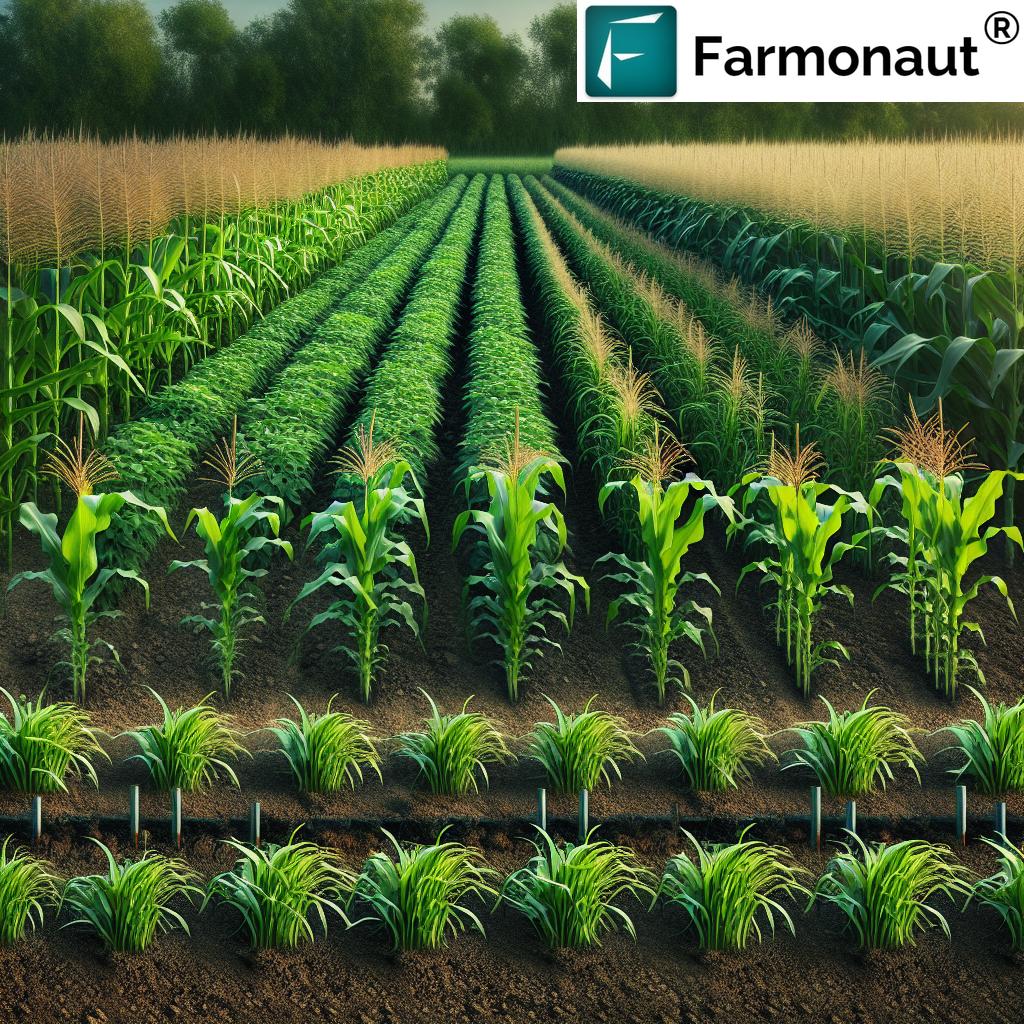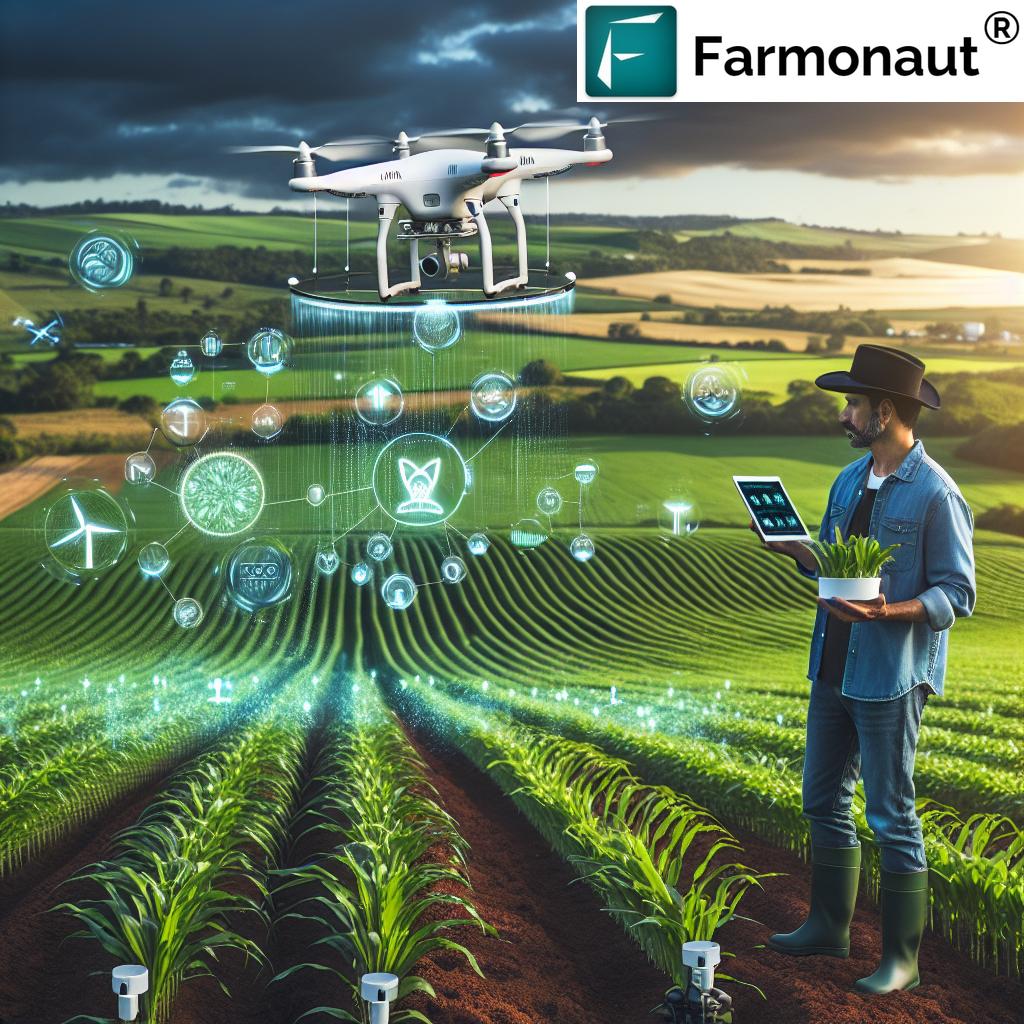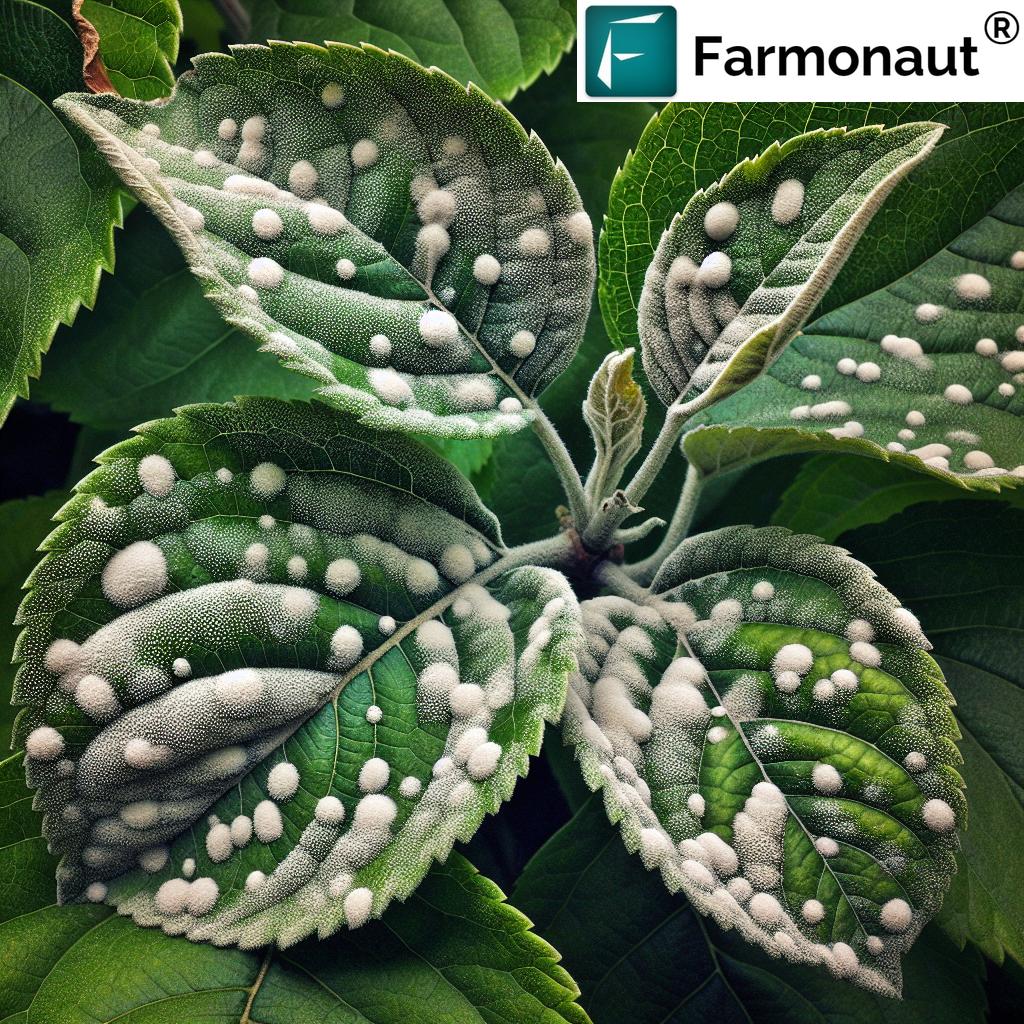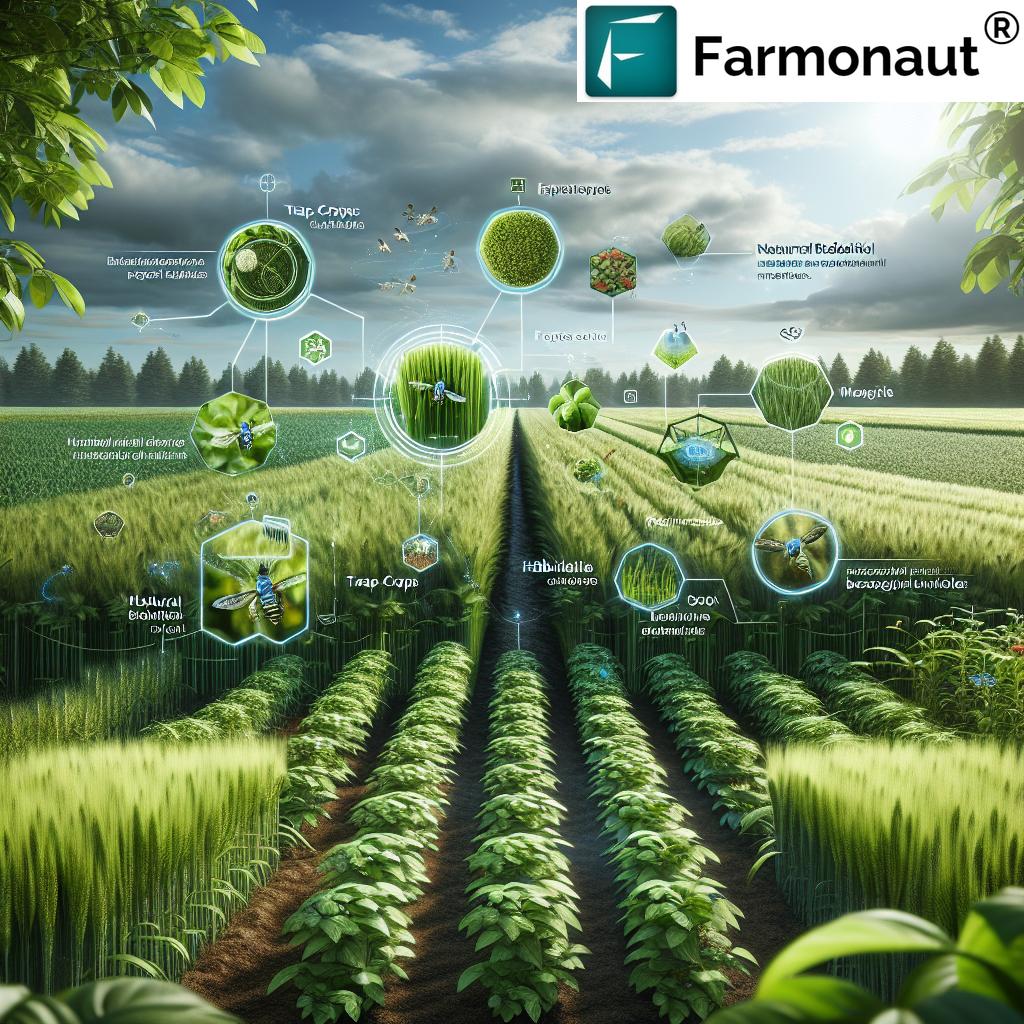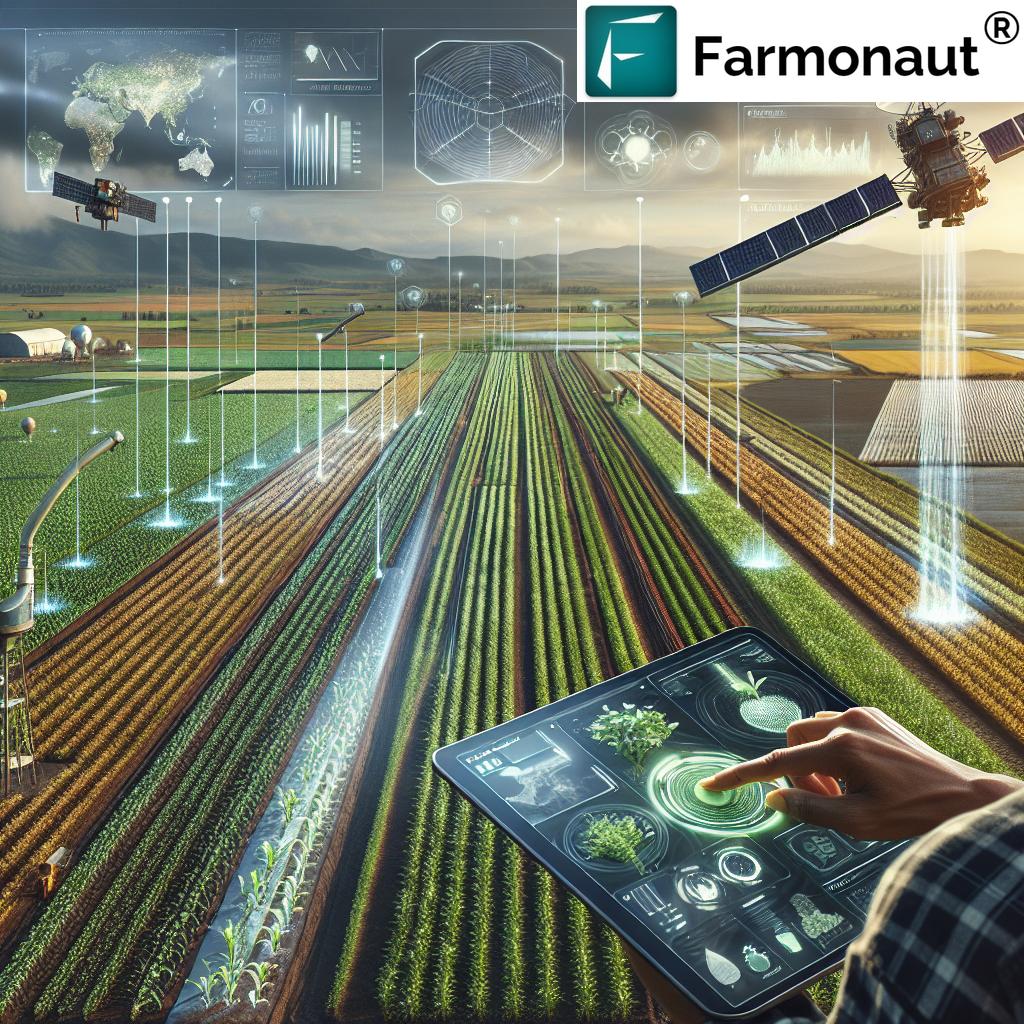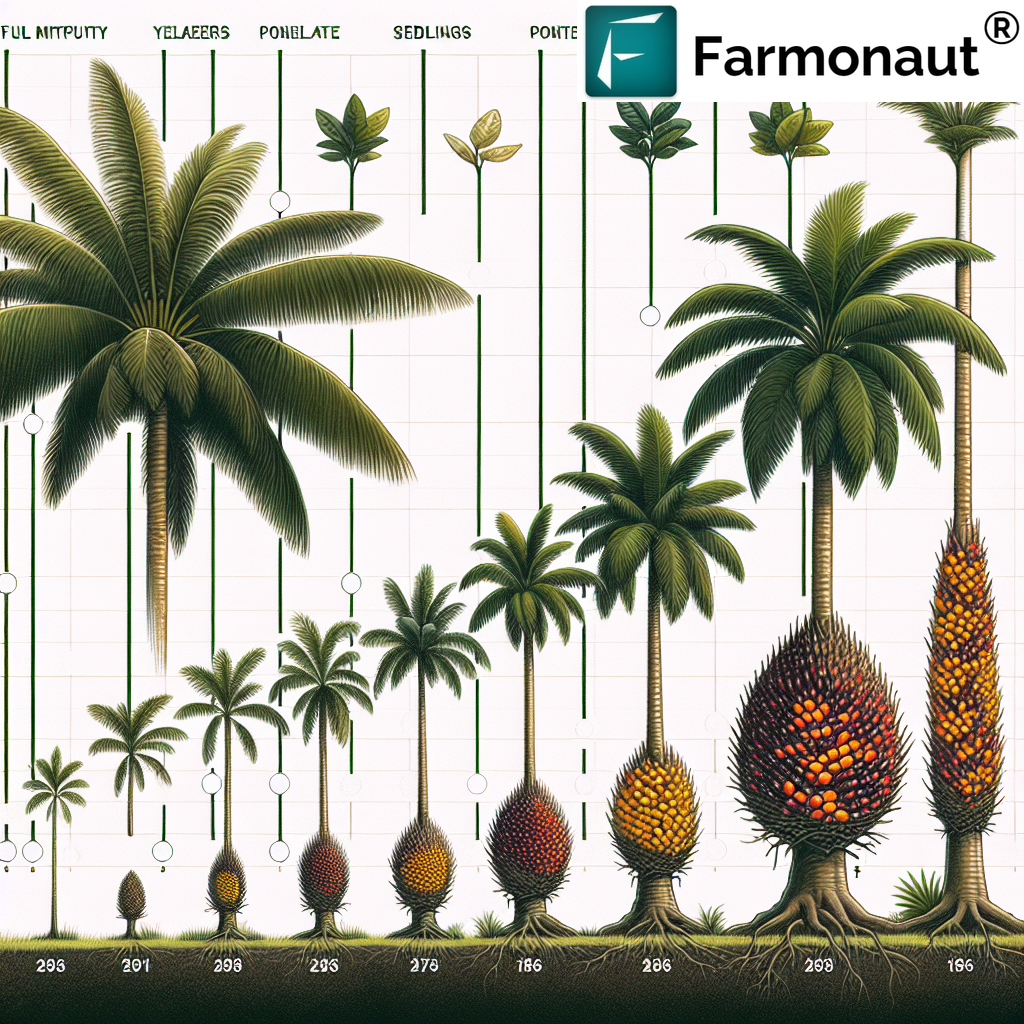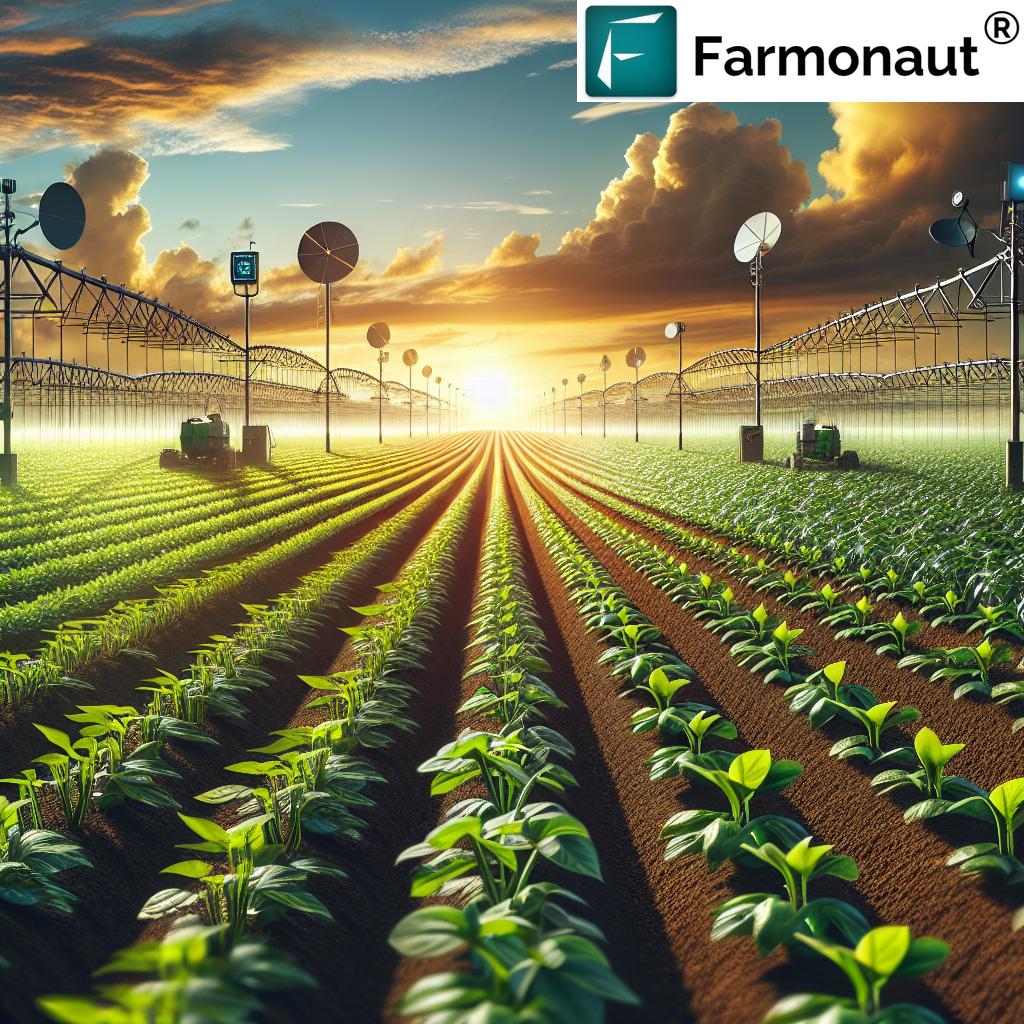7 Innovative Pest Management Hacks Revolutionizing Crops
Meta Description: Innovative pest management is revolutionizing agriculture, maximizing crop yields, and reducing environmental impact using AI, precision farming, and biological solutions. Explore cutting-edge, sustainable pest control methods that are shaping the future of eco-friendly farming.
“AI-driven pest management can reduce pesticide use by up to 30%, boosting sustainability in modern agriculture.”
- Summary & Introduction
- Integrated Pest Management (IPM): A Holistic Strategy
- Biological Hacks: Natural Pest Control for Crops
- Push–Pull Technology in Agriculture
- Soil Solutions: Biosolarization & Biofumigation
- Trap Cropping: Redirecting Pest Populations
- Hi-Tech Innovations: AI, Drones, IoT & E-Noses
- Precision Application Systems in Agriculture
- Biotechnology and Genetic Engineering
- Farmonaut’s Role in Sustainable Pest Control
- Innovative Pest Management Methods: Comparative Overview
- FAQ
- Conclusion
- Farmonaut Subscription Pricing
Summary & Introduction: Innovative Pest Management is Transforming Crops
In the fast-evolving world of agriculture, innovative pest management practices are revolutionizing crop protection, sustainability, and productivity. By integrating advanced technologies such as AI, IoT sensors, drones, and eco-friendly biological methods, modern farming transcends traditional, chemical pesticide-dominated approaches. Our focus now shifts to precision, ecological balance, and sustainable pest control methods that protect both yields and the environment.
The goal is clear: By reducing reliance on chemical pesticides, we not only safeguard our crops but also foster biodiversity, soil health, and human well-being. Let’s explore seven of the most innovative hacks in pest management that are transforming agriculture, farming, and forestry.
1. Integrated Pest Management (IPM): A Holistic Strategy for Sustainable Pest Control
What is Integrated Pest Management?
Integrated Pest Management (IPM) is an advanced, holistic approach—the gold standard in modern pest control for crops. Instead of depending solely on pesticides, IPM combines biological, cultural, physical, and chemical tools to manage pests in a balanced way. By employing multiple strategies, we can minimize environmental impact, preserve biodiversity, and enhance crop yields.
- Goal: Minimize pesticide use and reduce damage to crops and the environment
- Methods: In-depth monitoring, understanding pest life-cycles, implementing targeted and necessary measures only
- Benefits: Promotes sustainability, protects beneficial insects, maintains an ecological balance
Key Components of IPM:
- Monitoring: Frequent field scouting to detect pest populations and assess damage levels
- Preventive Measures: Crop rotation, using pest-resistant plant varieties, and proper timing of planting
- Mechanical & Physical Controls: Physical removal, traps, barriers, and mulching
- Biological Control: Use of natural predators, parasites, and pathogens (see below for details)
- Targeted Chemical Application: Only as a last resort, using selective pesticides to minimize non-target effects
A sustainable pest control strategy like IPM reduces chemical input while increasing precision, resulting in less pollution and healthier crops. Precision agriculture pest control integrated with IPM further amplifies these benefits—employing data-driven decisions to target interventions, save resources, and limit environmental harm.
Learn more about innovative technologies for smarter integrated pest management.
2. Biological Hacks: Natural Pest Control for Crops
As we move away from excessive chemical reliance, biological pest control emerges as a sustainable, natural method to suppress insect pest populations—
directly supporting the ecological balance of our farming systems.
Biological Control Agents (Predators, Parasites, & Pathogens)
Biological control utilizes beneficial organisms, such as predatory insects, parasitoid wasps, and entomopathogenic fungi (e.g., Beauveria bassiana), to manage pests like aphids, whiteflies, thrips, and weevils. This method is effective in controlling pest populations while having a minimal negative impact on the surrounding environment.
- Example: Introducing ladybugs to control aphids in vegetable crops
- Method: Release or encourage populations of beneficial predators and parasites in the field
- Fungi Use: Application of Beauveria bassiana offers a viable alternative to chemical insecticides for attacking soft-bodied pests
By embracing biological pest control, we reduce reliance on synthetic pesticides, supporting both crop health and overall ecosystem resilience. This approach is now foundational in IPM and precision agriculture pest control systems.
Further reading: Biological pest control agents
“Biological pest control methods have increased crop yields by 20% in precision farming systems worldwide.”
3. Push–Pull Technology in Agriculture: Innovative Crop Protection
In regions like Kenya and beyond, push–pull technology in agriculture is gaining acclaim as a brilliantly simple but highly effective pest management strategy.
It combines intercropping with special repellent (“push”) and trap (“pull”) plants to attract and redirect pests away from main crops.
How Push–Pull Technology Works:
- Push Plants: For example, Desmodium is intercropped among maize rows. Its scent repels stem borers and other insect pests.
- Pull Plants: The border of the field is planted with Napier grass – attracts pests away from the maize.
- Outcome: Main crops like maize or sorghum benefit from lower pest damage, reduced pesticide use, and increased yields.
This innovative pest management method has proven especially beneficial for smallholder farmers in Africa, but is adaptable to diverse agricultural contexts. When we combine push–pull with other IPM elements, results can be transformational for both yield and environmental preservation.
Push–Pull Technology in Crop Management
4. Soil Solutions: Biosolarization & Biofumigation for Sustainable Pest Control
Biosolarization
Biosolarization is a natural alternative to traditional soil fumigation. By combining solarization (trapping solar heat under plastic covers) with organic soil amendments (like compost or manure), this method uses heat and microbial activity to kill pests, suppress diseases, and promote soil health.
- How it works: Moist, organic-enriched soil is covered with clear or semi-transparent plastic. Sunlight raises soil temperature while decomposition of organic matter releases biocidal compounds.
- Results: Kills pests, weed seeds, and soilborne pathogens without chemicals—providing a highly effective, environmentally-friendly solution.
Read about Biosolarization in pest management
Biofumigation
Biofumigation leverages specific plants—especially members of the Brassicaceae family, such as mustard, cauliflower, and broccoli. When these plants are incorporated into the soil and begin to decompose, they release powerful volatile compounds that are toxic to soil pests and pathogens.
- Example: Chopped mustard greens plowed into the field before crop planting
- Outcome: Reduction in nematodes, fungi, and weed seedlings—without relying on harmful fossil-fuel-based chemicals
- Benefits: Improved soil structure and microbiome, better root growth, and healthier crops overall
Biofumigation: The Science of Harnessing Plant Power
Together, biosolarization and biofumigation exemplify how we can deploy natural pest control for crops in an innovative yet low-impact way, offering lasting benefits for agricultural sustainability and resource management.
5. Trap Cropping: Redirecting Pest Populations Effectively
Trap cropping is an innovative pest management method wherein we plant a secondary crop that’s even more attractive to pests than our main crop. The pests are thus redirected to the trap crop, reducing damage to the valuable, primary crop.
- Method: Choose a trap crop species preferred by the target pest
- Example: In cotton fields, planting alfalfa or sunflower at plot margins to attract and suppress aphid populations
- Benefits: Focus pest control interventions in smaller areas, reduce pesticide use, and often provide additional farm income from the trap crop itself
For integrated pest management programs, trap cropping strategies can be highly effective when coordinated with biological control and monitoring, ensuring pests are systematically controlled at the landscape level.
Trap cropping: An effective IPM strategy
6. Hi-Tech Innovations: AI, Drones, IoT & E-Noses in Precision Agriculture Pest Control
Today’s advanced technologies have dramatically streamlined and elevated pest control in agriculture. Let’s examine the latest breakthroughs enhancing our capacity to monitor, detect, and control pest populations with more precision than ever before.
- AI in Pest Management: AI and machine learning analyze vast data—including from weather, crop, and pest life cycles—to predict pest outbreaks and optimize intervention timing.
Farmonaut’s Jeevn AI Advisory System provides real-time, AI-based advice to farmers, helping them monitor insect outbreaks, diseases, and offers guidance on sustainable interventions. - IoT Sensors: Internet of Things (IoT)-based sensors continually monitor field conditions—like temperature, humidity, and soil moisture—enabling early pest identification and targeted, data-driven action. With real-time field data, we enhance both efficacy and efficiency of interventions.
How IoT is transforming pest management
- Drones for Pest Detection & Management: Drones equipped with multispectral and HD cameras rapidly scan large fields to identify pest hotspots and diseases before they escalate. They also allow for precision application systems in agriculture—applying treatments only where needed.
Read about drones in modern pest control
- Electronic Noses (E-Noses): Mimicking the human olfactory system, e-noses detect volatile organic compounds emitted by grains and pests—delivering rapid, non-destructive detection of infestations, even when insects are hidden or microscopic.
How E-Noses detect invisible pests
- Pheromone Traps: Synthetic pheromones are used to attract pests into traps—allowing for early detection, continuous monitoring of populations, and focused interventions before outbreaks impact yield.
Breakthrough innovations: Pheromone-based pest control
Harnessing the power of these precision agriculture pest control tools and AI-driven technologies is crucial for transforming modern pest management and ensuring higher crop yields, resource efficiency, and lower environmental risk.
Looking for uncompromised supply chain integrity?
Discover how Farmonaut’s Blockchain-Based Traceability solution ensures every product journey is transparent and secure, helping you build consumer trust in sustainable agriculture.
7. Precision Application Systems in Agriculture
Precision application systems agriculture involve using advanced sensors, GPS, and AI to precisely control where and when pesticides, water, and fertilizers are applied. Instead of broad, uniform spraying, inputs are targeted exactly where needed, dramatically reducing chemical usage and minimizing environmental impact.
- Example: Fields are mapped with real-time satellite or drone imagery (Farmonaut’s Large-Scale Farm Management platform provides such mapping and analytics)
- Operation: Application machinery is GPS-controlled, delivering precise treatments only to problem spots
- Benefits:
- Up to 40% reduction in pesticide use
- 15% increase in crop yields
- Conservation of both water and nutrients in the soil
Precision systems: The future of sustainable pest management
Other Farmonaut Solutions for Maximizing Sustainability
-
Carbon Footprinting: Track, analyze and reduce your farm’s environmental impact using real-time emission data.
-
Fleet Management: Manage agricultural machinery and logistics efficiently for safer and more sustainable operations.
-
Crop Loan & Insurance: Utilize satellite-based verification to streamline agricultural loans and insurance approvals.
Bonus: Biotechnology and Genetic Engineering—Engineering Crops for Pest Resistance
Biotechnology has added a powerful new toolkit to integrated pest management. By genetically engineering crops, we can incorporate pest resistance genes, reducing the need for external pest control and helping plants defend themselves.
-
Bt (Bacillus thuringiensis) Crops:
Crops like cotton and maize are engineered to express natural insecticidal proteins, lethal to pests such as caterpillars and beetles, but safe for humans and beneficial insects. - Additional genetic engineering strategies include developing crops that are unattractive to certain pests, or can better compete with weeds for resources.
- While these methods must be balanced for ecological and ethical considerations, they massively reduce pesticide input, support useful insects, and increase productivity.
Innovations in biotechnology for smarter IPM
Farmonaut’s Role in Sustainable & Innovative Pest Management
At Farmonaut, we are dedicated to making precision agriculture affordable, accessible, and scalable for everyone—from smallholder farmers to giant agribusinesses, government bodies, and agri-corporates.
Our advanced platform leverages real-time satellite imagery, artificial intelligence, and blockchain to provide:
- Real-time crop health, vegetation, and soil moisture monitoring
- AI-based advisory for pest and nutrient management
- Automated risk, disease, and pest outbreak warnings
- Resource management to minimize input wastage
- Farm-to-fork traceability
Farmonaut’s mobile, web and API features are designed so every farmer and business can benefit from these sustainable pest control methods, boosting yields while lowering both cost and environmental impact.
Our subscription-based model and open API ensure you always get the insights you need, tailored for your farm size and region.
Innovative Pest Management Methods: Comparative Overview
| Hack/Method Name | Technology Used | Estimated Effectiveness (% Pest Reduction) | Approximate Cost (per acre/application) | Environmental Impact |
|---|---|---|---|---|
| Integrated Pest Management (IPM) | Field monitoring, mechanical tools, data analytics | 50–70% | Low–Moderate | Low |
| Biological Control | Biological agents (predators, fungi), scouting | 45–65% | Moderate (cost of agents) | Low |
| Push–Pull Technology | Intercropping, trap/repellent plants | 40–60% | Low (seed + labor) | Low |
| Biosolarization | Solarization, organic amendments | 55–75% | Low–Moderate (plastic & organic) | Low |
| Biofumigation | Brassicaceae plants, volatile compounds | 40–65% | Low (green manure cost) | Low |
| Trap Cropping | Secondary crops, monitoring, targeted sprays | 35–55% | Low–Moderate | Low |
| Hi-Tech (AI/IoT/Drones/E-Nose) | Drones, AI, IoT sensors, e-noses | 60–85% | Moderate–High (technology cost) | Low–Medium |
| Precision Application Systems | GPS, sensors, variable rate tech | Up to 90% | Moderate | Low |
| Biotechnology (GM Crops) | Genetic engineering | 70–95% (targeted pests) | High (seed cost) | Low–Medium |
FAQ: Innovative Pest Management in Modern Agriculture
- Q: What is innovative pest management?
A: Innovative pest management refers to integrating advanced biological, technological, and sustainable methods to control pests, minimize reliance on chemical pesticides, and maintain environmental balance for increased crop yields. - Q: How does AI help in pest management?
A: AI analyzes vast datasets from satellite imagery, weather trends, and pest cycles to predict outbreaks and advise precise interventions, reducing pesticide usage and crop loss. - Q: What are the benefits of biological pest control?
A: It offers a natural, environmentally friendly alternative to chemicals by harnessing predators, parasites, and pathogens to reduce pest populations—supporting ecological balance and sustainable agriculture. - Q: Can innovative pest management increase farm yields?
A: Yes. Data-driven and biological pest control methods can increase yields by up to 20% while reducing synthetic pesticide inputs and environmental risks. - Q: Are these innovative hacks suitable for all farming sizes?
A: Yes. Solutions like Farmonaut’s platform are scalable from smallholder to large-scale operations, providing tailored, affordable tools for pest management and beyond. - Q: Where can I access Farmonaut’s solutions?
A: You can access our web, Android, and iOS apps via the links above or through our API for developers and businesses. - Q: How affordable are these methods for everyday farmers?
A: Many innovative techniques (like biological control, biosolarization, and IPM) are low-cost, while tech solutions (AI, IoT, drones) are becoming accessible thanks to platforms like Farmonaut and flexible subscription models.
Conclusion: The Future is Bright for Sustainable, Innovative Pest Management
Innovative pest management is transforming agriculture, farming, and forestry worldwide. By integrating holistic, sustainable practices with advanced technologies like AI, drones, IoT, and precision application systems, we empower farmers to manage pests more effectively than ever before.
Traditional methods that over-relied on chemical pesticides are giving way to targeted, ecological approaches that minimize environmental impact, promote crop health, and boost productivity. Whether on a small family plot or vast agro-enterprise, adopting these seven innovative hacks ensures a healthier tomorrow for our soil, food, and planet.
Farmonaut stands at the forefront of this revolution, making real-time monitoring, AI advisory, and sustainable farm management accessible to all. Explore our apps and API to join the future of crop protection and resource-smart farming today!






